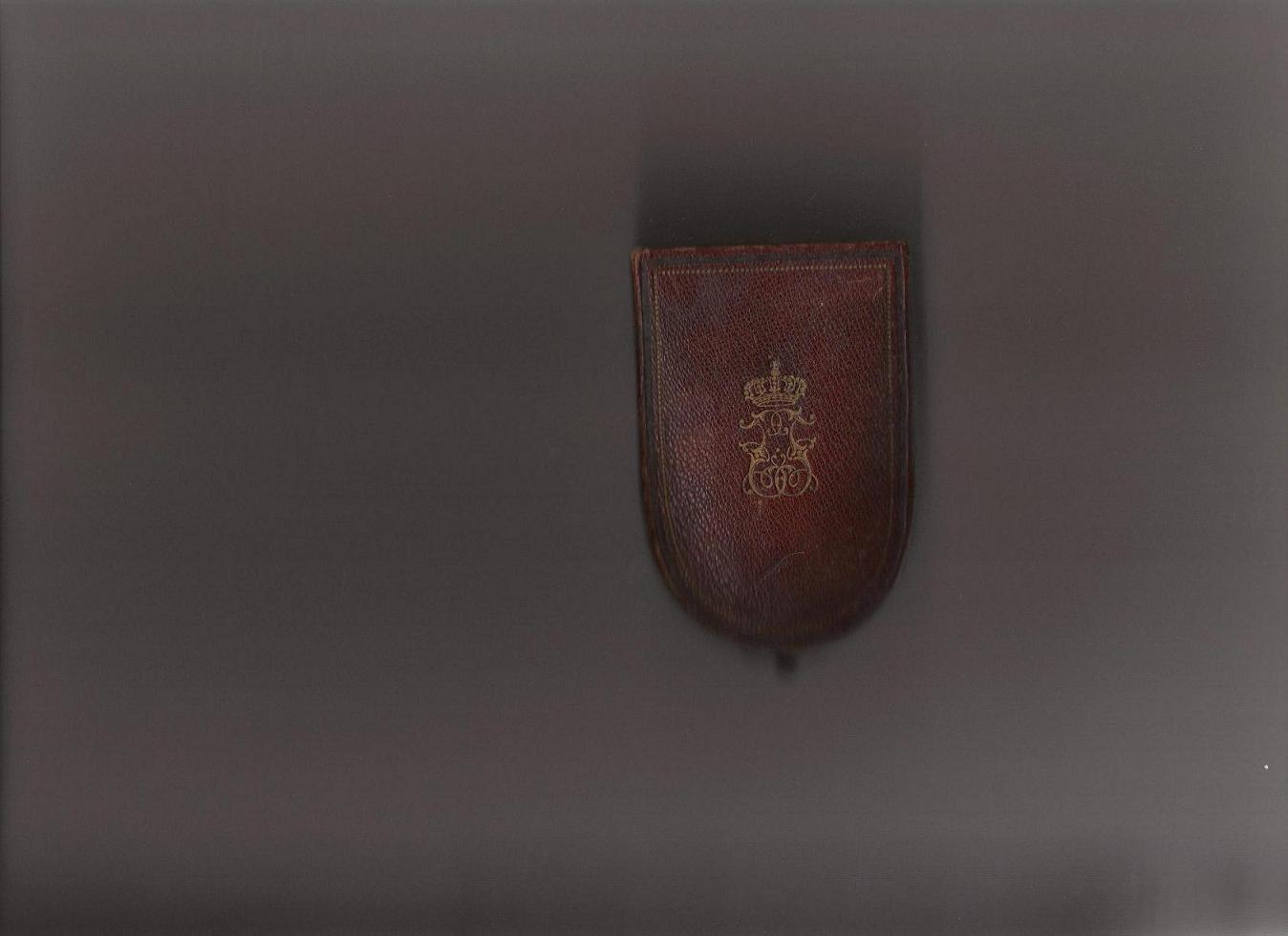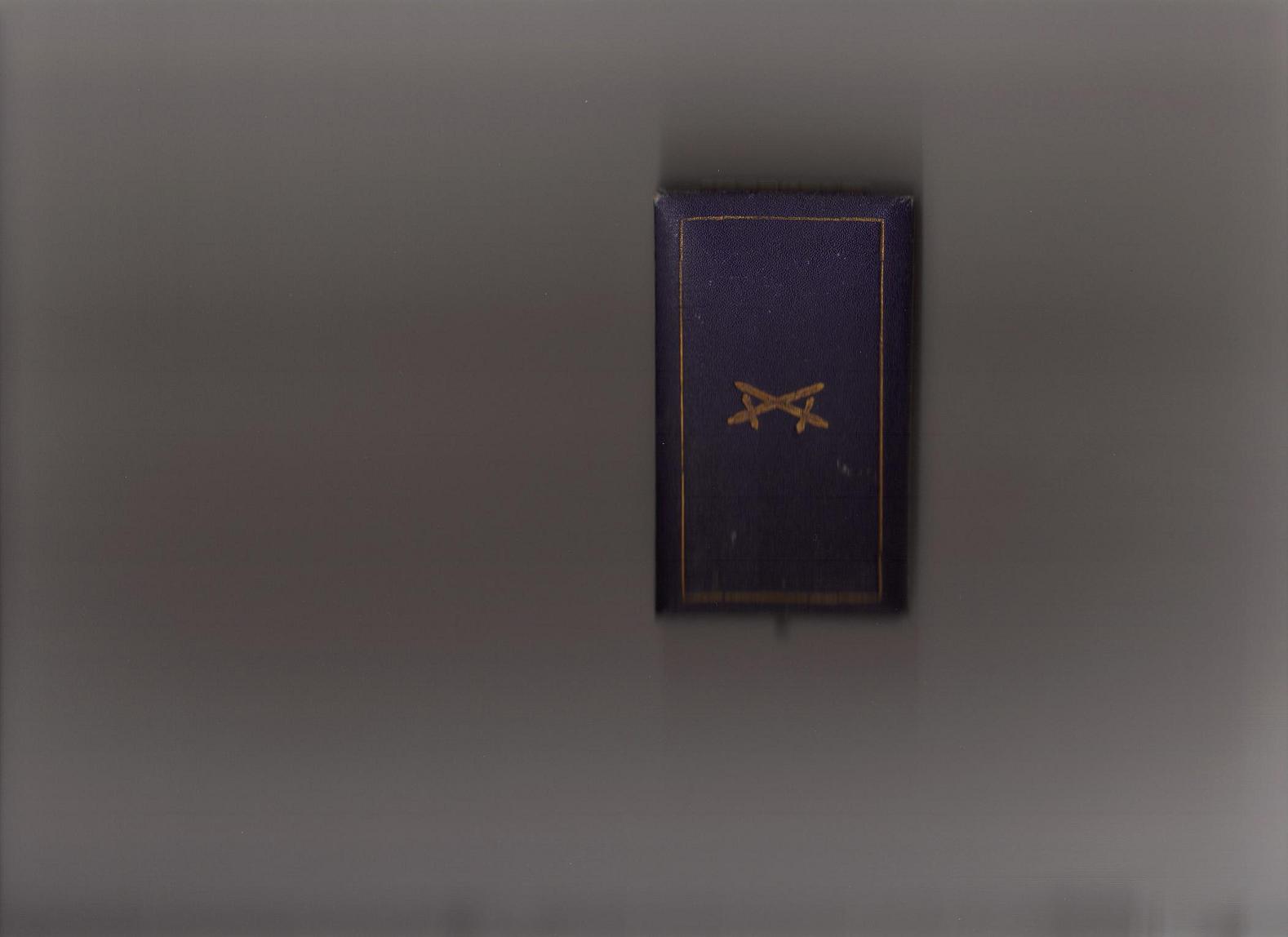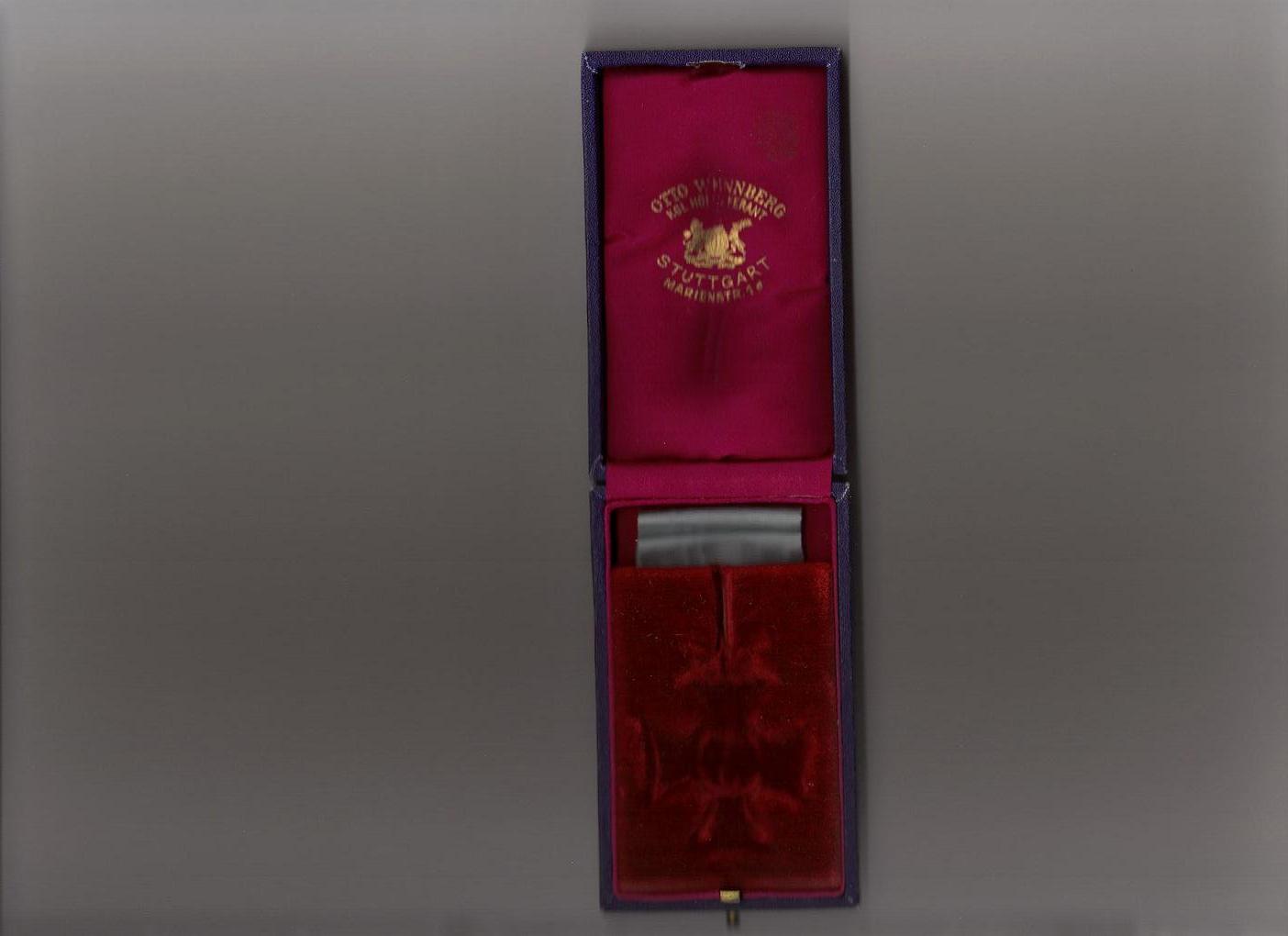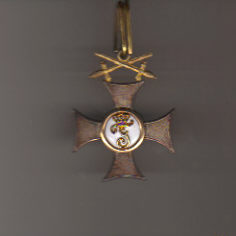-
Posts
809 -
Joined
-
Last visited
Content Type
Profiles
Forums
Blogs
Gallery
Events
Store
Posts posted by Yankee
-
-
Both you Gentlemen had the right Duchy and as you correctly thought issued before the 20th century
 . The case is mid 19th for a Zahringen Lion Knight. The interior is a deep purple.0
. The case is mid 19th for a Zahringen Lion Knight. The interior is a deep purple.0 -
My apologies for not making a scan of the interior, lid only opens 90 degrees
 0
0 -
Hmm, may be "Baden, Erinnerungskreuz f?r freiwillige Kriegshilfe" ?!

Nope, but you are warm
 0
0 -
Hello Gentlemen
Who lives here?

 0
0 -
Hi Yankee,
As I understand it, early issue pieces had the swords directly fixed to the cross. The later, WWI issue pieces, had the double eyelet suspension system, with which we are more familiar. However, there exist examples with a true hinged arrangement which apparently were awarded for a short period either before or between the two types mentioned above. Below is an example of this third type of suspension on a commander?s badge.
Hopefully, Uwe will see this thread and give us all of the details.
Regards,
Wild Card
Hi Wild Card
Understand what youy mean, thanks for posting that beautiful example
 Certainly true a picture is worth a thousand words. I went on the net to find any further info on Otto Wennberg and strangely enough only came up with Der Rittmeister who has an example of a knight 2nd class w/swds
Certainly true a picture is worth a thousand words. I went on the net to find any further info on Otto Wennberg and strangely enough only came up with Der Rittmeister who has an example of a knight 2nd class w/swds  ( swords in gold ) this type looks more like the hinged type as you talked about, certainly not the rings or loops that one normally comes across. Unfortunately no luck when Otto Wennberg was in business but judging by the example that Der WRittmeister has, safe to say he was an early order manufacturer.
( swords in gold ) this type looks more like the hinged type as you talked about, certainly not the rings or loops that one normally comes across. Unfortunately no luck when Otto Wennberg was in business but judging by the example that Der WRittmeister has, safe to say he was an early order manufacturer.Sincerely
Yankee
0 -
Hello Yankee:
This is not a typical WWI piece or maker. With the centers being gold, the piece would most likely be from the 1870-71 or colonial period. It could also be a very early WWI piece. Unfortunately, there is no way to tell for certain, unless someone knows when THIS manufacturer made FO badges, and if there was a finite window in time.
An unusual and very nice piece!
Congratulations,
"SPM"
Hi SPM
Thanks for your insight
 , an excellent idea to find out when Otto Wennberg was in business, must admit I never knew of this jeweler before
, an excellent idea to find out when Otto Wennberg was in business, must admit I never knew of this jeweler before 
Sincerely
Yankee
0 -
-
-
-
Hello
Would any memebers please tell me what time era this knight 2nd class/swds was issued. The center is gold and the swords are directly fixed to the cross, first I have seen this kind of sword mounting. Thanks
Sincerely
Yankee
0 -
For any collector interested in 1870/71 medal groups take a look at DNW's next auction lots of material
0 -
Hello Brian,
the museum close to the S?dbahnhof in Vienna is the "Heeresgeschichtliches-Museum"! The place where any collector of Imperial Austrian Orders, Decorations & Militaria can dream about "what I would like to have...".
Now, the Museum has been re-orderd in a more modern way, but in the past there were many carved wood showcases, all full of crosses of the MMThO in its 3 classes... besides other orders, medals, uniforms, flags, etc.
It's still and always a must for us collectors and enthusiasts.
The Iron Crown III Class of your friend, can be a very interesting piece (would it be possible to see a scan of it?). I'm not sure if the first Kriegsdekoration to be added to the Iron Crown should have been without enamel (this was for sure to the Leopold Orden, where the first KD's were wreaths made of a green-toned gold alloy, although exceptions exist...).
Anyways, I suspect that yes, it should be a piece from 1866 (but, I repeat, to see a picture would allow to give a final response).
Best wishes,
Enzo
Hi Enzo
Glade to hear the army museum is still there, had been some time ago that I was there but hard to forget all those Maria Theresa's. Unfortunately I will not have the possibility to send a foto out, he is no longer alive and the badge was sold off at an earlier time. I remember the badge well for it was one of my favorites unfortunately as a student didn't have so much funds to make a offer. I am certain the war decorations was solid gold on both sides of the Eagle not around the shield. I have never seen another like it to this day. Also the badge was not hallmarked which as I understand prior to 1866 or 67 they were not marked. Any possibility the war decorations for the Iron Crown was introduced in the Italian Campaign. Are there documented groups of the Iron Crown w/war decoration being in enamel. If that is the case I'd suspect then the piece that I saw was pre 1866. As I recall there was no enamel inside the crown. About what year did the Austrians replace the design of the badge to the current form.
Sincerely
Brian
0 -
Hello,
actually, it's quite difficult to find any type of original MMThO crosses... I'm feeling a lucky collector, for having had the chance to put a very old Commander's Cross in my collection.
I know that all the original crosses have to be in gold, also the pieces awarded late in the 1st World War. The Ordenskanzlei ordered new crosses to Rothe & Neffe and ordered in the same time to let older pieces from the Order's treasure to be repaired and/or adapted.
Not all the silver-gilt and bronze-gilt crosses are to be considered as fakes, because Rothe and Mayer (and possibly, also Rozet & Fischmeister) made Order's crosses for private purchase.
Many years ago, I've seen a bronze-gilt Knight's Cross with the "star" mark struck on the loop and its quality was the same of a gold piece.
In the later years, some Austrian "creative" people has put on the market gold knight's crosses of the MMThO: such pieces are of fairly good quality but quite different from the original: in any case, many collectors have been deceived and spent a lot of money for a "late XX Century" piece.
It's important to keep in mind that also during WW1 the MMThO was always made with the highest jeweller's quality.
The same for the St. Stephen's Order: yes, this one also was awarded in gold only, until the end of the A-H Monarchy (silver-gilt pieces were also available for private purchase).
Best wishes,
Enzo
Hi Enzo
Thanks for the info
 if I'm ever lucky enough to find myself a gold example I'll scan to you first. There is a military museum in Vienna not too far from the train station that has dozens upon dozens of these beauties & as I recall with a foto of the recipients. A friend of mine had an interesting example of the Iron Crown from the 1866 war 3rd class cased. The war decoration wreaths was solid gold( no enamel ) and the crown was also solid gold. Would it have been an earlier badge that was reissued with war decoration for the 1866 conflict or was the war decoration wreaths ( solid gold )issued before 1866 maybe the Italian campaigns?
if I'm ever lucky enough to find myself a gold example I'll scan to you first. There is a military museum in Vienna not too far from the train station that has dozens upon dozens of these beauties & as I recall with a foto of the recipients. A friend of mine had an interesting example of the Iron Crown from the 1866 war 3rd class cased. The war decoration wreaths was solid gold( no enamel ) and the crown was also solid gold. Would it have been an earlier badge that was reissued with war decoration for the 1866 conflict or was the war decoration wreaths ( solid gold )issued before 1866 maybe the Italian campaigns? Sincerely
Brian
0 -
...and reverse:

Best wishes,
Enzo
Hi Elmar
What a great piece

 not every day one gets to see a early commander. I do recall that all the orginal exampels were made in gold and the silver gilt were just fakes. Just curious in the later stages of WWl were the badges issued in silver gilt at all, like the other Austrian orders. Does the same rule apply for the St.Stephen as well where only orginals were in gold? Would they be issued toward end of WWl in gold too or are there orginal silver gilt examples?
not every day one gets to see a early commander. I do recall that all the orginal exampels were made in gold and the silver gilt were just fakes. Just curious in the later stages of WWl were the badges issued in silver gilt at all, like the other Austrian orders. Does the same rule apply for the St.Stephen as well where only orginals were in gold? Would they be issued toward end of WWl in gold too or are there orginal silver gilt examples?Sincerely
Yankee
0 -
Dave,
They all got the decorations for general military merit.
But Dr. P. Frank, British, got the knight 2. Class war decoration in 1871.
Yankee,
After 1892, all veterans of the 1866 and 1870/71 wars who got their decoration for war merit could apply for wearing swords. Afterwards they went to a jeweller to order them. So all swords are looking a bit different. The awards handed out for China 1900/01 were the first once with homogeneous swords.
The first decoration with swords was awarded in 1893. And for the first time you could read ?Kriegsverdienst? on the certificate.
Bernd
Hi Bernd
Thanks for that
 now the hard part begins, finding a knight 1st class from an early maker before the swords were put on since the recipient died during the 1870/71 war.
now the hard part begins, finding a knight 1st class from an early maker before the swords were put on since the recipient died during the 1870/71 war. Sincerely
Yankee
0 -
 Furst Alexander
Furst AlexanderA merit medal from Alexander 1st time
 0
0 -
Just for example the knight 2nd class.
In 1870 and 1871:
1411 war decorations (swords)
107 decorations for general military merit.
That is about 7% of the total.
It is a mess, I know. You can?t see it on the medal bar, certificate or Armeebefehl.
Thank you Gentlemen for all your kindness in sharing such detailed information, fascinating to learn so many were awarded to foreigners especially Americans and a Canadian
 Does somebody know how that came about ( Americans awarded ) Was it mandatory ( recall ) that the veterans put swords above their cross after 1891 or was it at their pleasure? I understand from a collector friend who helpfully pointed out that many were done by local jewelers ( swords added on ) would any ever be done by a court jeweler?
Does somebody know how that came about ( Americans awarded ) Was it mandatory ( recall ) that the veterans put swords above their cross after 1891 or was it at their pleasure? I understand from a collector friend who helpfully pointed out that many were done by local jewelers ( swords added on ) would any ever be done by a court jeweler?Most Sincerely
Yankee
0 -
It were about 1.500 knight 1st and 2.500 knight 2nd class.
Hi Bernd D
Thanks a lot for the info, any chance you would have an idea in how many were awarded ( knight 1st & 2nd class ) for the Franco-Prussian War? Not having all the info on the early makers are there any clear cut ways to distinguish an early 1866 era made piece to a later 1905 era made example?
Sincerely
Yankee
0 -
Hi Claudio
Any possibility that you could find out the number issued for the knight 1st class & knight 2nd class (1866 1905)
Sincerely
Yankee
0 -
Hello Gentlemen
Can any member share with us who were the ( Franco/Prussian war era ) early manufacturers of the Bavarian Military Merit Order knight 1st class & 2nd class? I only know of two for certain Adam Hausinger & Eduard Quellhorst. Like to locate a proper period piece of a knight 1st class for a group. Would it also be a possibility that the early badges were not jeweler marked at all? Thank You
Yankee
0 -
But at least we have the Morton and Eden catalogues of what the ANS collection once was. A good friend of mine gave many things to them, some of which I know never made it into the sale, so this raises some interesting questions. I know he was very disappointed with the almost total lack of care and preservation the things he gave to them were getting and, at the time of his death, was thinking about asking them to give him his stuff back. I'm glad he didn't live to see the sale, though.
I remember viewing wall to wall Grand Cross sets in their display rooms, a good many on the German States & Russia. I was surprised not to see them in the catalog. Perhaps a museum should be created for the sole purpose of just
orders & medals run by dedicated collectors.
0 -
I have been a medal collector since 13 years of age, can certainly understand Ed's concern of medals being misused for improper purposes or falling into the wrong hands. Mark is doing something out of the ordinary that few would ever contemplate. To collect both fields simultaneously in such detail is no easy task. As a collector I can see the passion for imperial uniforms they are beautiful and historic. Dress uniforms were designed ( loops ) to hold decorations here is where the collector needs to decide how far to take it. There can't be too many imperial uniforms that still exist surely time would have taken its toll. Just as decorations they need to be preserved and if necessary restored for future generations.
Sincerely
Brian
0 -
And, I might add, Neal saw to it before his death that the various pieces and parts of his collection were, in total, donated to the appropriate museums where they would be displayed in perpetuity. None were or, hopefully, ever will be offered to the open/collector?s market.
Regards,
Wild Card
Great he had the good fortune not to stick it in the ANS
0 -
Hi Mark
The one that Igor has posted is a nice example a WWl era foreign example. A Russian one from that period would not have that center beautifully detailed.
0







New German Imperial medal bar
in Germany: Imperial: The Orders, Decorations and Medals of The Imperial German States
Posted
You gotta that bend in the bar, for sure only massive orginals can do that.
that bend in the bar, for sure only massive orginals can do that.
Great stuff
